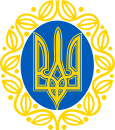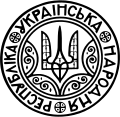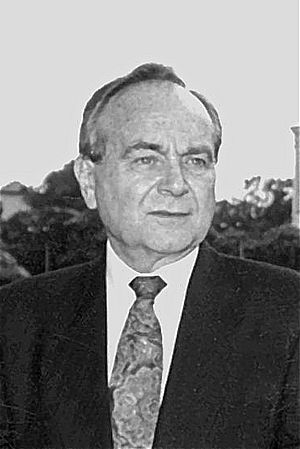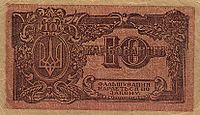Ukrainian People's Republic facts for kids
Quick facts for kids
Ukrainian People's Republic
|
|||||||||||||||||||||
|---|---|---|---|---|---|---|---|---|---|---|---|---|---|---|---|---|---|---|---|---|---|
| 1917–1918 1918–1920 |
|||||||||||||||||||||
|
Coat of arms
(1918–1920) |
|||||||||||||||||||||
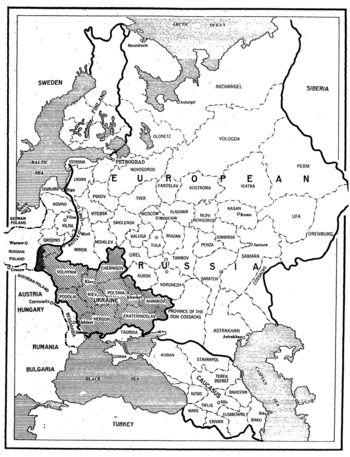
The map from The New York Times showing the provisional boundaries of the Ukrainian People's Republic emerged from the collapsed Russian Empire in 1918.
|
|||||||||||||||||||||
| Status | Autonomy within the Russian Republic (1917–1918) Partially-recognized state (1918–1920) Government-in-exile (1920–1992) |
||||||||||||||||||||
| Capital | Kyiv | ||||||||||||||||||||
| Common languages | Official: Ukrainian Widespread: Russian Minority languages: Yiddish, Polish, German, Belarusian, Romanian, Bulgarian, Greek, Urum, etc. |
||||||||||||||||||||
| Religion |
|
||||||||||||||||||||
| Demonym(s) | Ukrainian | ||||||||||||||||||||
| Government | People's republic | ||||||||||||||||||||
|
• 1917–1918
|
Mykhailo Hrushevskyi | ||||||||||||||||||||
|
• 1918–1920
|
Directorate | ||||||||||||||||||||
| President-in-exile | |||||||||||||||||||||
|
• 1926–1954
|
Andriy Livytskyi | ||||||||||||||||||||
|
• 1954–1965
|
Stepan Vytvytskyi | ||||||||||||||||||||
|
• 1965–1989
|
Mykola Livytskyi | ||||||||||||||||||||
|
• 1989–1992
|
Mykola Plaviuk | ||||||||||||||||||||
| Legislature | Central Rada Labor Congress |
||||||||||||||||||||
| Historical era | World War I | ||||||||||||||||||||
|
• Autonomy declared
|
23 June 1917 | ||||||||||||||||||||
|
• Republic proclaimed
|
20 November 1917 | ||||||||||||||||||||
|
• Independence
|
22 January 1918 | ||||||||||||||||||||
|
• Directorate formed
|
13 November 1918 | ||||||||||||||||||||
|
• Hetmanate defeated
|
14 December 1918 | ||||||||||||||||||||
|
• Unity Act signed
|
22 January 1919 | ||||||||||||||||||||
| 18 March 1921 | |||||||||||||||||||||
|
• Authority handed over to post-Soviet Ukraine
|
15 March 1992 | ||||||||||||||||||||
| Currency | Karbovanets Hryvnia |
||||||||||||||||||||
|
|||||||||||||||||||||
The Ukrainian People's Republic (UPR), also known as the Ukrainian National Republic (UNR), was a country in Eastern Europe that existed between 1917 and 1920. It was created after the February Revolution in Russia. In March 1917, a group of socialist parties formed the Central Council in Kyiv. This council was recognized by the Russian government at the time.
After the October Revolution in Russia, the Ukrainian People's Republic declared its full independence on January 22, 1918. During its short life, the republic changed its government several times. It started as a socialist republic led by the Central Council and later by the Directorate, with Symon Petliura as a key leader.
For a period in 1918, the Ukrainian People's Republic's government was replaced by the Ukrainian State, led by Pavlo Skoropadskyi. This government was supported by Germany. From late 1919, the UNR worked with the Second Polish Republic. However, by November 1920, the republic lost its remaining land to the Bolsheviks. The Peace of Riga treaty in March 1921 officially ended the Ukrainian People's Republic.
After the October Revolution, many different groups fought for control in Ukraine. These included the Ukrainian People's Republic, the Bolsheviks, the White Movement, Poland, and other local groups. This period was a civil war in Ukraine, part of the larger Russian Civil War. Eventually, the Russian SFSR (Soviet Russia) took control of much of Ukraine. This led to the creation of the Ukrainian Soviet Socialist Republic, which became a part of the Soviet Union in 1922.
Contents
History
How Ukraine Declared Autonomy
In 1917, the Central Council of Ukraine declared that Ukraine would be an independent region within the Russian Republic. This happened on June 10, 1917. The main governing body was called the General Secretariat of Ukraine, led by Volodymyr Vynnychenko.
The Russian Prime Minister, Alexander Kerensky, recognized this new government. However, he limited its power to only five areas. Vynnychenko initially disagreed but later returned to lead the Secretariat after the Central Council accepted Kerensky's terms.
Declaring Full Independence
After the October Revolution in Russia, a group of Bolsheviks tried to take control in Kyiv in November 1917. The Central Council supported them in removing Russian forces from Kyiv. After this, the Central Council announced that Ukraine would have even greater self-rule, but still with ties to Russia.
On November 20, 1917, the Central Council officially announced the territory of the Ukrainian Republic. It included many regions and invited others to join through a vote. The Central Council stated that it was the main government in Ukraine because there was no clear government in Russia after the revolution. It called the October Revolution a "civil war" and hoped for peace.
The Rise of Soviet Power
Soon, the Bolsheviks realized that the Central Council would not support their revolution. They tried to take power in Kyiv in December 1917 but failed. So, they moved to Kharkiv.
The Bolsheviks in Ukraine declared the Ukrainian People's Republic's government illegal. They announced their own government, the Ukrainian People's Republic of Soviets, with its capital in Kyiv. The Bolshevik Red Army then entered Ukraine from Russia to support this new Soviet government.
During this time, other smaller Soviet republics also appeared in Ukraine. These included the Odessa Soviet Republic and the Donetsk-Krivoi Rog Soviet Republic. Some of these were directly supported by Lenin and became part of the Russian SFSR.
Key Events in the Republic's Early Years
- March 1917: The February Revolution in the Russian Empire led to democratic changes.
- March 17: The Central Council of Ukraine was formed.
- April 9: Mykhailo Hrushevsky returned from exile to lead the Central Council.
- April 11: The Ukrainian Military Society of Hetman Polubotok was created.
- May 2-4: The Ukrainian National Congress took place in Kyiv. It confirmed the Central Council's members.
- June 18-24: The 2nd Ukrainian Military Congress supported the Ukrainization of the Russian Army.
- June 24: The 1st Universal (Declaration) of the Ukrainian Central Council was announced.
- June 28: The General Secretariat of Ukraine was elected as the state power.
- July 16: The 2nd Universal (Declaration) was adopted.
- November 7: The October Revolution happened in Petrograd. The Central Council condemned it.
- November 20: The 3rd Universal (Declaration) was announced, outlining the republic's territory.
- December 1917: The Central Council adopted laws for a General Court and taxes.
- December 23: The Ukrainian delegation was chosen for peace talks in Brest-Litovsk.
- January 6, 1918: Peace talks began in Brest. Ukraine asked to be recognized as a sovereign state.
- January 16: A law was passed to create the Ukrainian National Army.
- January 22: The 4th Universal (Declaration) was adopted, declaring full independence.
- January 29: The Battle of Kruty took place.
- February 9: The Brest peace treaty was signed with Germany and Austria-Hungary.
- February 10: The Ukrainian government moved to Zhytomyr due to advancing Russian Bolshevik forces.
- February 27: A new calendar and monetary system (hryvnia) were introduced. The Tryzub (Trident) was adopted as the coat of arms.
- April 1918: Ukrainian People's Republic troops took control of several cities in the Donbass region.
- April 29: The All-Ukrainian Agrarian Congress elected Pavlo Skoropadsky as the Hetman of Ukraine.
Becoming Independent
Because of attacks from Soviet Russia, the Central Council declared Ukraine a fully sovereign state on January 22, 1918. This was called the Fourth Universal of the Ukrainian Central Council. However, less than a month later, on February 9, 1918, the Red Army captured Kyiv.
To get military help, the Ukrainian government signed the Treaty of Brest-Litovsk with Germany and Austria-Hungary. Germany then helped the Ukrainian Army push the Bolsheviks out of Ukraine. By April 1918, German and Austro-Hungarian forces had completely removed the Bolsheviks from Ukraine.
Germany then took a more direct role in Ukraine. On April 29, 1918, the Germans arrested and disbanded the Central Council. They did this to stop social changes and ensure food supplies were sent to Germany and Austria-Hungary. The German authorities also arrested the Ukrainian Prime Minister, Vsevolod Holubovych.
The Hetmanate Period
After the Central Council was removed, a new conservative government took over. This was the Hetmanate, led by Hetman Pavlo Skoropadsky. Skoropadsky was a former officer who favored large landowners.
His government had little support from Ukrainian activists. However, it was able to create a working administration and establish diplomatic ties with many countries. It also signed a peace treaty with Soviet Russia. During this time, the Hetmanate printed millions of Ukrainian textbooks and established many Ukrainian schools, two universities, and the Ukrainian Academy of Sciences.
The Hetmanate government also supported wealthy landowners taking back land from peasants. This led to many peasant uprisings. Activists like Petliura and Vynnychenko worked to overthrow Skoropadsky. On July 30, 1918, a Russian revolutionary assassinated the German commander, von Eichhorn, in Kyiv.
As Germany and Austria-Hungary were losing World War I, Skoropadsky formed a new government that wanted to join a future non-Bolshevik Russia. In response, Ukrainian socialists announced a new revolutionary government called the Directorate of Ukraine on November 14, 1918.
Key Events During the Hetmanate
- April 29, 1918: Pavlo Skoropadsky was elected Hetman of Ukraine.
- May 7: The government wanted to add Crimea to the Ukrainian State.
- May 15: A treaty was signed with Germany and Austria-Hungary for a loan to buy Ukrainian food.
- May 28: A delegation from Kuban arrived, proposing to unite with Ukraine.
- June 12: Landowners in Tavria supported joining Ukraine.
- July 24: Ukraine and Germany ratified the Brest Peace Treaty.
- August 27: The Ukrainian State blocked trade with Crimea due to its anti-Ukrainian policies.
- October 16: The Hetman declared the revival of Cossack traditions.
- November 6: German authorities transferred Black Sea fleet ships to Ukraine.
- November 13: The Soviets canceled the Brest Peace Treaty and refused to recognize Ukraine's independence.
- November 14: The anti-Hetman Uprising began.
- November 26: The Ukrainian Academy of Sciences was created.
- December 14: The Hetman gave up his power and left for Germany.
The Directorate Takes Control
The Directorate became very popular and gained support from some of Skoropadsky's military units. Their army surrounded Kyiv on November 21. After three weeks, Skoropadsky resigned, and the Directorate took control of Kyiv on December 19, 1918.
The Bolsheviks invaded Ukraine from Kursk in late December 1918. On January 16, 1919, Ukraine officially declared war on Russia. On January 22, 1919, the Directorate officially united with the West Ukrainian People's Republic. However, the West Ukrainian People's Republic kept its own army and government. On February 5, the Bolsheviks captured Kyiv.
Throughout 1919, Ukraine was in chaos. Many armies fought for control: the Ukrainian Republic, the Bolsheviks, the Whites, foreign powers, Poland, and anarchist groups. By November 10, 1920, the Directorate lost its remaining land to the Bolsheviks. In March 1921, the Peace of Riga divided control of the territory between Poland, the Russian SFSR, and the Ukrainian SSR.
As a result, parts of Galicia and Volhynia became part of Poland. The areas to the east and south became part of Soviet Ukraine.
After its military defeat, the Directorate continued to exist as a government-in-exile. In October 1921, it launched some guerrilla attacks into central Ukraine. However, these forces were surrounded and defeated by Bolshevik cavalry on November 17, 1921.
Key Events During the Directorate
- December 14, 1918: The Directorate of Ukraine took power after the Hetman left.
- December 19: The Directorate entered Kyiv.
- December 31: The Directorate protested Soviet Russia's invasion of Ukraine.
- January 4, 1919: The Directorate adopted the law about the Ukrainian currency, the hryvnia.
- January 8: The government adopted a Land Law based on socialist ideas.
- January 16: War was declared on Moscow after peace talks failed.
- January 22: The Unification between Ukraine and West Ukraine was declared in Kyiv.
- January 23: The Labor Congress, started by the Directorate, opened in Kyiv.
- February 2: The Directorate moved from Kyiv to Vinnytsia due to Bolshevik advances.
- February 17: The Directorate asked for help from the Entente countries and the US against the Bolsheviks.
- April 4: Ukraine protested Polish military attacks on Ukrainian territory.
- May 9: Symon Petlyura was elected head of the Directorate.
- June 12: Finland reestablished diplomatic ties with Ukraine.
- June 16: The Vatican approved Ukraine's Ambassador to the Holy See.
- June 18-21: Ukraine and other nations protested the recognition of Admiral Kolchak's government as the supreme government of Russia.
- June 20-21: A temporary agreement was signed with Poland in Lviv, setting a border line.
Rebellions and Uprisings
Many uprisings happened during the time of the Ukrainian People's Republic. Some were against the government, others against the Soviet rule, and some against foreign forces. Records show that 268 uprisings occurred in Ukraine between 1917 and 1932. In over 100 regions, peasants fought against forces that were taking their food by force.
Some notable uprisings and groups included:
- Free Territory (led by Nestor Makhno)
- Otaman Grigoriev
- Otaman Oskilko Affair
- Otaman Zelenyi Uprising
- Kholodnyi Yar (Cold Ravine)
- Otaman Kamenyuka
- Free Cossacks
- Zazymia Uprising
Government in Exile
The government of the Ukrainian People's Republic continued to operate in exile after its defeat. It was based in cities like Warsaw, Paris, Weimar, Kissingen, Munich, and Philadelphia.
During World War II, Taras Bulba-Borovets, with support from the President of the Ukrainian People's Republic in exile, Andrii Livytskyi, began organizing military units. These units were part of the UPA and were loyal to the UPR Government.
In 1991, after Ukraine became independent from the Soviet Union, the Ukrainian National Council recognized the new state of Ukraine as the successor to the Ukrainian People's Republic in exile. The powers and symbols of the old government were transferred to the newly elected President of Ukraine.
International Recognition
The Ukrainian People's Republic was officially recognized by several countries in February 1918. These included the Central Powers of World War I (Germany, Austria-Hungary, the Ottoman Empire, and Bulgaria). It was also recognized by Bolshevik Russia, the Baltic States (Estonia, Latvia, Lithuania), Georgia, Azerbaijan, Romania, Czechoslovakia, and the Holy See. Other countries like Switzerland, Sweden, Denmark, and Persia recognized it unofficially.
Later in 1918, Russia withdrew its recognition of independent Ukraine. In 1920, Symon Petliura and Józef Piłsudski signed the Treaty of Warsaw (1920). This treaty set the borders between Ukraine and Poland. Countries that had recognized the Ukrainian People's Republic stopped their relations with its government-in-exile once they recognized the Soviet government in Kyiv.
Important Diplomatic Actions
- Treaty of Brest-Litovsk: Signed on February 9, 1918, with the Central Powers.
- Peace treaty with Soviet Russia: Signed on June 12, 1918. Russia later canceled it.
- Peace treaty with Don Republic: Signed on August 8, 1918.
- Unification Act: Signed on January 20, 1919, uniting the Ukrainian People's Republic and the West Ukrainian People's Republic.
- Loss of Kyiv: Kyiv was lost to the Soviets on February 2, 1919, causing a political crisis.
- Participation at the Paris Peace Conference, 1919: Ukraine sent a delegation to the peace conference.
- Treaty of Warsaw (1920): Signed with Poland.
Population and People
According to a census from 1897, the Ukrainian People's Republic had over 20 million people. This included seven former Russian regions and three districts of the Taurida Governorate on the mainland.
The population was made up of:
- Ukrainians – 73%
- Russians – 11%
- Jewish people – 9%
- Germans – 2%
- Poles – 2%
- Belarusians – 1%
- Romanians – 1%
- Other groups – 1%
How the Country Was Divided
On March 4, 1918, the Ukrainian government passed a law about how Ukraine would be divided. It said Ukraine would have 32 "zemlia" (lands), each managed by its own local council. However, this law was not fully put into action. When Pavlo Skoropadsky took power in April 1918, he changed the system back to the old "guberniya" (governorate) administration.
Military Forces
The main headquarters for the republic's armed forces was called the General Bulawa, usually located in Kyiv. However, because of constant conflicts with Soviet Russia and Germany, its physical location often changed.
Main Military Groups of the UPR
- Sich Riflemen
- Free Cossacks
- Zaporizhian Corps
- Ukrainian Steppe Division
- Ukrainian Marines
- 1st Riflemen-Cavalry Division (Gray-Coats)
- Blue-Coats
- Sloboda Ukraine Haidamaka Kosh
- 3rd Iron Riflemen Division
- Ukrainian People's Republic Air Fleet
- Navy of the Ukrainian People's Republic
Main Military Groups of the West Ukrainian People's Republic
- Ukrainian Galician Army: This was the military force of the West Ukrainian People's Republic.
Money and Banking
In December 1918, a temporary law was passed about the money used by the UPR. The main currency was the "karbovanets." Each karbovanets was worth 17.424 parts of pure gold. It was divided into two "hrivnas" or 200 "shahs."
There were several banks in the republic. The most well-known were the Ukrainabank and the Soyuzbank. These were created by Khrystofor Baranovsky, who led a cooperative movement.
Maps
Green indicates UPR-controlled territory, red indicates the Red Army control, light yellow for the White Army control, dark yellow for Germany, blue for Poland, and brown for Romania. Bold black line indicates the borders of modern Ukraine.
See also
 In Spanish: República Popular Ucraniana para niños
In Spanish: República Popular Ucraniana para niños



